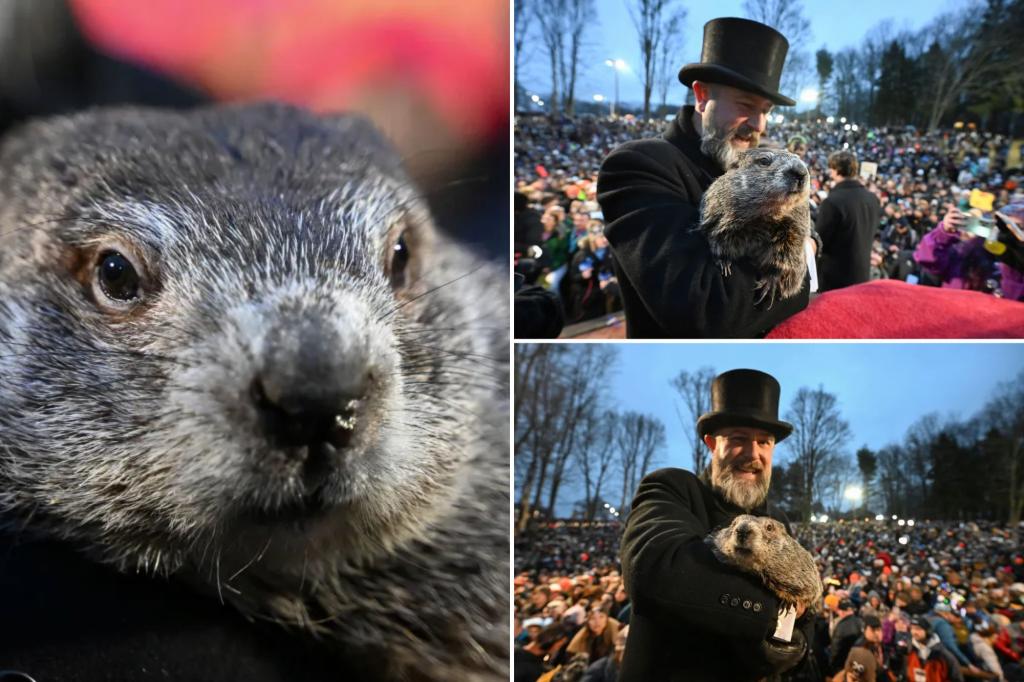The sleepy town of Punxsutawney, Pennsylvania, once again became the center of attention as Punxsutawney Phil, the world’s most famous groundhog, emerged from his burrow on February 2nd, 2025. Amidst a crowd of eager onlookers and under the watchful eye of Pennsylvania Governor Josh Shapiro, Phil saw his shadow, thus foretelling six more weeks of winter according to the time-honored tradition. This year’s Groundhog Day held special significance as it marked Phil’s first as a father, following the birth of his offspring, Sunny and Shadow, in March 2024.
The event, steeped in 132 years of folklore, drew a crowd of over 40,000 to Gobbler’s Knob, eager to witness the annual spectacle. However, despite the fanfare and unwavering belief in the tradition, Phil’s accuracy in predicting the changing seasons has been questioned. Studies by the National Oceanic and Atmospheric Administration (NOAA) indicate that over the past two decades, Phil’s predictions have only aligned with reality approximately 35% of the time. This year, Governor Shapiro preemptively addressed criticisms and defended the tradition, particularly against a petition by PETA to replace Phil with a vegan cake. The Governor lightheartedly expressed his staunch support for Phil, vowing to protect the furry prognosticator from any attempts to dethrone him.
The origins of Groundhog Day can be traced back to the European Christian holiday of Candlemas, celebrated on February 2nd. During Candlemas, Christians would bring candles to church for blessings. An old English folk song connected the weather on Candlemas to the duration of winter, suggesting that if Candlemas Day was bright and sunny, winter would have “another flight,” implying a prolonged cold season. This belief spread throughout Europe and eventually reached Germany, where a hedgehog became integrated into the tradition. If the hedgehog saw its shadow on Candlemas, it signified a “second winter.”
German settlers brought this tradition with them to the United States, adapting it to the local fauna by substituting the hedgehog with the groundhog. The first documented mention of Groundhog Day in Punxsutawney appeared in a local newspaper in 1886, and the first official celebration at Gobbler’s Knob took place the following year in 1887. Since then, Punxsutawney Phil has become the most prominent figure in this unique weather-predicting ritual.
While Punxsutawney Phil enjoys the greatest notoriety, he is not the only groundhog tasked with forecasting the weather. Across the country, other groundhogs participate in similar ceremonies, and some have even boasted more accurate predictions. Notably, Staten Island Chuck in New York has an impressive 85% accuracy rate over the past 20 years, according to NOAA data. General Beauregard Lee of Georgia also stands out with an 80% accuracy rate over the same period. These statistics place both Chuck and General Lee significantly ahead of Phil in terms of predictive prowess.
Interestingly, despite his lower accuracy rating, Punxsutawney Phil remains the undisputed celebrity of Groundhog Day. His fame has transcended local tradition, becoming a national and even international phenomenon. The annual event attracts significant media attention and draws thousands of visitors to Punxsutawney, boosting the town’s economy and placing it firmly on the map. While the scientific community may question the validity of Phil’s predictions, his cultural impact is undeniable, representing a charming and enduring piece of American folklore. Regardless of his meteorological accuracy, Punxsutawney Phil continues to capture the public’s imagination, offering a lighthearted and whimsical start to February.
The debate surrounding Phil’s accuracy and the ethical considerations raised by animal rights groups like PETA add another dimension to the Groundhog Day tradition. While some advocate for a move away from using live animals for entertainment and prediction, others firmly believe in preserving the historical and cultural significance of the event. This ongoing dialogue reflects the evolving relationship between humans and animals, and the search for a balance between tradition and modern sensibilities. Regardless of one’s stance on the issue, Groundhog Day continues to spark conversation and generate interest, reminding us of the enduring power of folklore and the unique ways in which humans connect with nature and the changing seasons.

